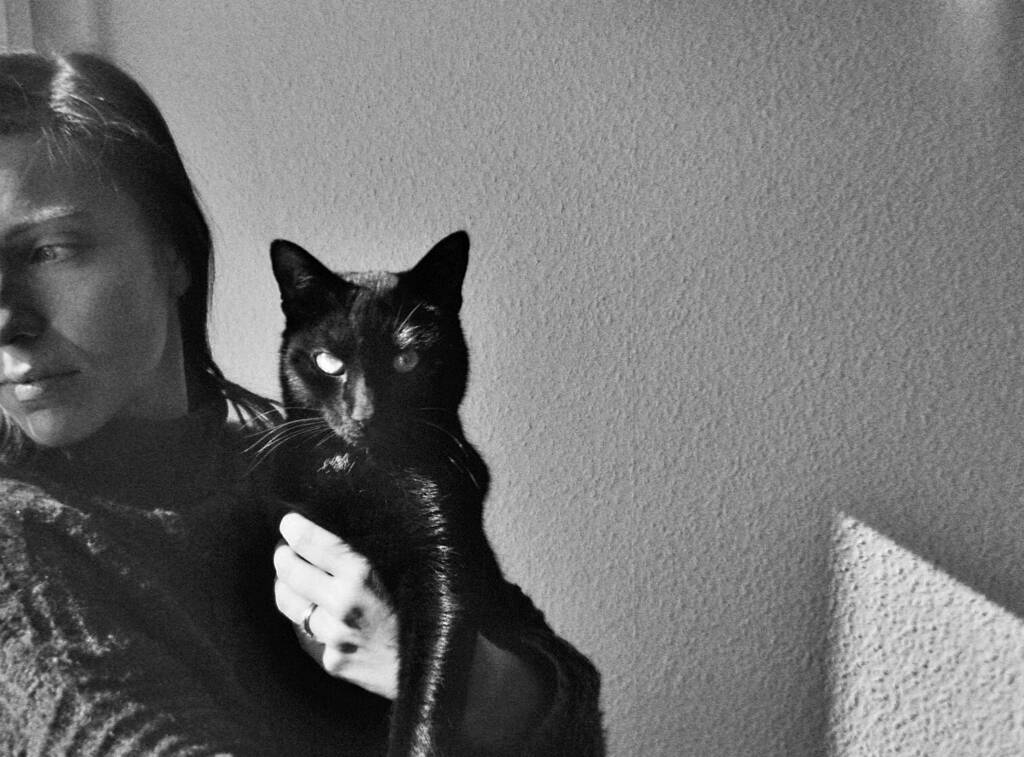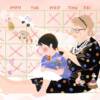Writing by Belle Campbell // photograph by Ramona Mahrla
 The Age of the Witch is dawning once more. In the spiritual black hole of modern life, more and more young people, particularly women, are turning to witchcraft, occultism, astrology, and other esoteric practices, ditching organised religion for alternative spirituality. Due to the popularity of fast-growing apps like Co-Star, which boasted around 20 million downloads in April of 2021, you’re more likely now than ever to be asked for your ‘Big 3’ (sun, moon, and rising signs) rather than your ‘star sign’. On Instagram, the #witch has around 15.7 million posts, comprising memes, infographics and screen-caps catering to the witchy aesthetic. However, it is undeniably the growth and influence of TikTok which has re-invigorated the surge of ‘baby witch’ awakenings among young people worldwide. With over 18.0 billion views, a brief exploration of the #witchtok reveals a rapidly growing community of predominantly young women sharing spell recipes, crystal charging techniques, tarot readings, protection charms and manifestation tips. So why the sudden fascination with a practice and lifestyle that, although severely misunderstood by many, has been happily existing on the internet already for many years. Put differently, why is witchcraft cool again?
The Age of the Witch is dawning once more. In the spiritual black hole of modern life, more and more young people, particularly women, are turning to witchcraft, occultism, astrology, and other esoteric practices, ditching organised religion for alternative spirituality. Due to the popularity of fast-growing apps like Co-Star, which boasted around 20 million downloads in April of 2021, you’re more likely now than ever to be asked for your ‘Big 3’ (sun, moon, and rising signs) rather than your ‘star sign’. On Instagram, the #witch has around 15.7 million posts, comprising memes, infographics and screen-caps catering to the witchy aesthetic. However, it is undeniably the growth and influence of TikTok which has re-invigorated the surge of ‘baby witch’ awakenings among young people worldwide. With over 18.0 billion views, a brief exploration of the #witchtok reveals a rapidly growing community of predominantly young women sharing spell recipes, crystal charging techniques, tarot readings, protection charms and manifestation tips. So why the sudden fascination with a practice and lifestyle that, although severely misunderstood by many, has been happily existing on the internet already for many years. Put differently, why is witchcraft cool again?
Modern witchcraft, astrological and Wiccan practices undoubtedly have a significant connection to pagan and pre-Christian folkloric knowledge systems, however, many of the hallmarks of contemporary practices are younger than you would believe. Founded by amateur archaeologist and Count Olaf look-alike Gerald Gardener, Wicca (not to be confused with witchcraft or paganism generally) was popularised by the 1954 publication of Witchcraft Today, wherein Gardener exposed his initiation into the ‘New Forest Coven’ and detailed many of the practices now adopted on #witchtok, such as keeping a Book of Shadows or the celebration of pagan holidays. Although Gardener and the cast of admittedly problematic characters that succeeded him are fascinating (Gardener and his coven once tried to hex Hitler), what is most interesting to me is how witchcraft was adopted by the women’s liberation movement. The New-Age resurgence of ‘alternative spirituality’ was particularly resonant with the 20th century counter-cultural movements of feminism, socialism and de-colonisation in their anti-establishment ethos and critique of the oppression of non-male, Christian, cis-het and western values. In 1968, the feminist collective W.I.T.C.H. famously performed a hex on Wall Street, protesting the bicameralism of patriarchy and capitalism, declaring that ‘if you are a woman and dare to look within yourself, you are a Witch.’
However, although this revival of occultism and radical spirituality allowed many women to see themselves and their bodies as worth of worship and respect, the New-Age movement has been validly criticised for its gender essentialism and cultural appropriation of indigenous and non-Western practices. Worryingly, many of these habits have continued into the 21st century, now exacerbated e-consumerism and influencer culture (see Lorde’s Mood Ring for a reflection of the transparency of the sage-burning, yoga-retreating ‘wellness’ aesthetic). To be sure, witches, astrologers and occultists have made flourishing businesses out of their practices for centuries, and panic over the commercialization of spirituality may be a little misplaced in a system which enables and oftentimes necessitates the commercialization of pretty much anything. The danger arises, however, where corporations such as Sephora start selling ‘witch kits’ of white sage bundles and tarot decks to mass consumer audiences with little to no thought for the origins and meanings of the practices they are profiting off.
Although corporations such as Sephora have undoubtedly contributed to the rising ‘witch wave’ of late, they – as all market-based corporations do – are merely capitalising on an already rapidly growing trend. So, what is the appeal? For many, the attraction to witchcraft and other esoteric practices lies in the possibility of a customisable and individualised spirituality that offers the metaphysical connection and belonging of organised religion, without the dogma. As of 2017, more than a quarter of US adults now say that they think of themselves as spiritual but not religious, as author Pam Grossman notes in her book Waking the Witch: Reflections on Women, Magic, and Power. Similarly, author of Enchantments: A Modern Witch’s Guide to Self-Possession, Mya Spalter remarks that ‘being a witch means not needing an intermediary between yourself and the divine’ (The Witch Wave #33). Furthermore, COVID-19 and the accompanying lockdowns and periods of self-isolation over the past year and a half have forced many young people to break from the diversions and constant stimulation of the work/play/study cycle that many of us inhabit. During the first major Sydney lockdown in 2020, I distinctly remember thinking to myself how good it felt to truly retreat into my introversion, and really celebrate being by myself, but by the time the new year rolled around I had already let myself be sucked back into the relentless demands of ‘real life’.
Yet despite the appeals to witchcraft, it has not been without its critics. Philosopher and sociologist Theodor Adorno, in his polemic study of New-Ageism, ‘The Stars Down to Earth’, claimed that a system like astrology ‘caters above all to narcissism’ (Adorno, 30) of consumers, who ‘accept it because it exists, without much reflection, provided only that their own psychological demands somehow correspond to the offer’ (Adorno, 15). Since these assertions, society in general has certainly frenzied itself over a perceived ‘cult of identity’ growing in Millennials and Gen Z as per social media – the root of all evil in society, naturally. Surely, the diluted and streamlined pop astrology of glossy magazines and Instagram, and universal ‘pick-a-card’ tarot readings on YouTube do little to combat these stereotypes. However, writers such as Chani Nicholas are re-conceptualising knowledge systems such as astrology as tools for ‘radical self-acceptance’ and reflection. In this way, the process of uncovering the elements of a birth chart becomes like completing a puzzle. Even if you encounter pieces that don’t quite fit into your vision of yourself at that time, you are still learning something about yourself that you wouldn’t have normally considered.
Other critics chafe at the ‘irrational’ fatalism of witchcraft, arguing that the determinism of birth charts, tarot readings and astrological forecasts are confining, likening them to repressive ideologies. However, as Tabitha Prado-Richardson notes in her essay, ‘Who Needs Astrology?’ it is important to remember, that even though your roommate might authoritatively claim that she will ‘never date a Scorpio again’, ‘astrology has not manifested power structures along the lines of its signs. It is merely annoying to its detractors.’ Further, the denigration and dismissal of witchcraft and astrology as ‘irrational’, encourages the pervasive ideology of ‘bureaucratic rationalism’ (Weber) which has been weaponised against non-Western religion, culture, and spirituality for centuries. I argue that the cultivation of an acknowledgement for the waxing and waning of personal and social energy, whether it be ordained by some higher power or not, is invaluable to emotional sustainability in our society. This belief, which is so intrinsic to witchcraft, resists the neo-liberal post-feminist mantras of ‘totalized self-responsibility’ (Prado-Richardson), which claim that personal failures and successes are entirely contingent on ceaseless efforts of self-improvement and goal-chasing. However, astrology and witchcraft allow us to remove that ingrained burden from our shoulders and acknowledge the cyclical processes of growth, diversification, and cultivation.
It reminds us that, as much as we would like, we cannot control everything, and to have faith in ourselves, even if the world seems faithless.






